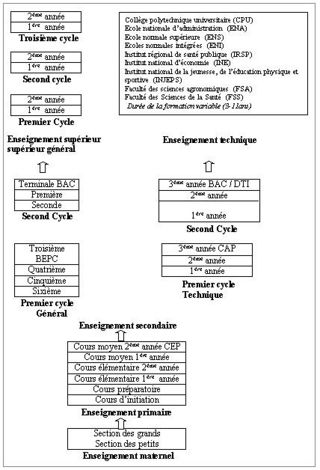Welcome to the Virtual Education Wiki ~ Open Education Wiki
Benin: Difference between revisions
| Line 26: | Line 26: | ||
== School-level education == | == School-level education == | ||
[[Image:Edsyst.jpg|left|thumb|320px|Source : http://www.ibe.unesco.org/en/worldwide/unesco-regions/africa/benin/profile-of-education.html]] | [[Image:Edsyst.jpg|left|thumb|320px|Source : http://www.ibe.unesco.org/en/worldwide/unesco-regions/africa/benin/profile-of-education.html]] | ||
'''Pre-school''' | |||
'''Primary level''' | |||
'''Secondary level''' | |||
'''Vocational and Technical''' | |||
== Further and Higher education == | == Further and Higher education == | ||
Revision as of 12:01, 24 April 2011
Experts situated in Benin
None.
Benin in a nutshell

Benin, officially the Republic of Benin, is a country in Western Africa. It borders Togo to the west, Nigeria to the east and Burkina Faso and Niger to the north; its short coastline to the south leads to the Bight of Benin.
Its size is just over 110,000 sq km with a population of almost 9,325,032 (CIA July 2011 est.).
Its capital is the Yoruba founded city of Porto Novo, but the seat of government is the Fon city of Cotonou.
Benin was known as Dahomey until 1975.
French is the official language of Benin, but most people speak an African language. Traditional religious beliefs are professed by about 60% of the population. Islam is the religion of about 15% of the people, most of whom live in the north. Christianity, especially Roman Catholicism, is the religion of about 20%, the great majority of whom live in the south.
For a longer summary see Wikipedia or http://www.internationaleducationmedia.com/benin/
Education in Country
(sourced from http://en.wikipedia.org/wiki/Education_in_Benin) Education in Benin is neither free nor mandatory. In 1996, the gross primary enrollment rate was 72.5 percent, and the net primary enrollment rate was 59.3 percent. A far greater percentage of boys are enrolled in school than girls: in 1996, the gross primary enrollment rate for boys was 88.4 percent as opposed to 55.7 percent for girls; the net primary enrollment rates were 71.6 percent for boys and 46.2 percent for girls. Primary school attendance rates were unavailable for Benin as of 2001. While enrollment rates indicate a level of commitment to education, they do not always reflect children's participation in school. Because of a rapid increase in the enrollment rate, the student/teacher ratio rose from 36:1 in 1990 to 53:1 in 1997. The overall adult literacy rate is nearly 40%. Only 25% of women in Benin are literate.
School-level education
Pre-school
Primary level
Secondary level
Vocational and Technical
Further and Higher education
Universities in Benin
The National University of Benin ((French) Université Nationale du Bénin) is the principal university in the country of Benin. The university was founded in 1970 as the Université du Dahomey. In 1975 the name was changed to Université Nationale du Bénin. Its name is abbreviated to UNB. It is composed of 19 institutions and six campuses. The main campus is the Université d'Abomey-Calavi (UAC). Enrollment at UAC was over 16,000 in 1999, including over 3,300 women.
The University of Benin maintains ten branches
- The Campus of Abomey Calavi
- The Faculty of Economics and Management (FASEG)
- The Faculty of Law and Political Science (FADESP)
- The Faculty of Arts and Social Science (FLASH)
- The Faculty of Science and Technology (FAST)
- The Faculty of Health Science (FSS)
- The University of Parakou (UNIPAR)
- The School of Applied Economics and Management (ENEAM)
- The National School of Administration and Prosecutor Training (ENAM)
- The Poly Technical School of Abomey Calavi (EPAC)
- The Teachers’ Training School of Porto-Novo (ENS)
- The Institute of Mathematics and Physics (IMSP)
- The Faculty Agricultural Science (FSA).
Some private higher institutions are also accredited by the Ministry of National Education. Altogether 94 higher institutions are accredited.
